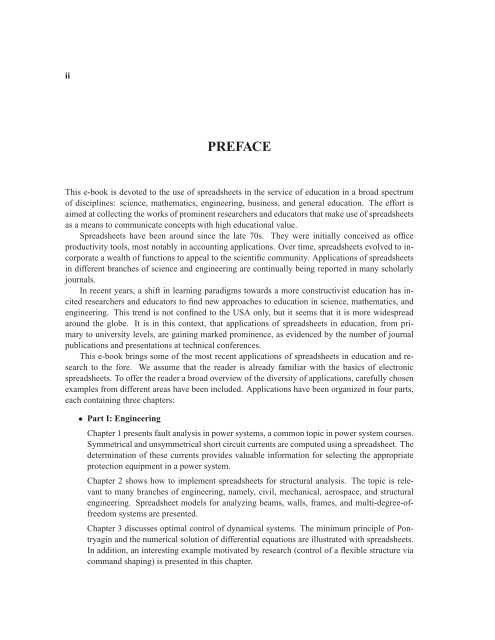chapter 3 - Bentham Science
chapter 3 - Bentham Science
chapter 3 - Bentham Science
You also want an ePaper? Increase the reach of your titles
YUMPU automatically turns print PDFs into web optimized ePapers that Google loves.
ii<br />
PREFACE<br />
This e-book is devoted to the use of spreadsheets in the service of education in a broad spectrum<br />
of disciplines: science, mathematics, engineering, business, and general education. The effort is<br />
aimed at collecting the works of prominent researchers and educators that make use of spreadsheets<br />
as a means to communicate concepts with high educational value.<br />
Spreadsheets have been around since the late 70s. They were initially conceived as office<br />
productivity tools, most notably in accounting applications. Over time, spreadsheets evolved to incorporate<br />
a wealth of functions to appeal to the scientific community. Applications of spreadsheets<br />
in different branches of science and engineering are continually being reported in many scholarly<br />
journals.<br />
In recent years, a shift in learning paradigms towards a more constructivist education has incited<br />
researchers and educators to find new approaches to education in science, mathematics, and<br />
engineering. This trend is not confined to the USA only, but it seems that it is more widespread<br />
around the globe. It is in this context, that applications of spreadsheets in education, from primary<br />
to university levels, are gaining marked prominence, as evidenced by the number of journal<br />
publications and presentations at technical conferences.<br />
This e-book brings some of the most recent applications of spreadsheets in education and research<br />
to the fore. We assume that the reader is already familiar with the basics of electronic<br />
spreadsheets. To offer the reader a broad overview of the diversity of applications, carefully chosen<br />
examples from different areas have been included. Applications have been organized in four parts,<br />
each containing three <strong>chapter</strong>s:<br />
• Part I: Engineering<br />
Chapter 1 presents fault analysis in power systems, a common topic in power system courses.<br />
Symmetrical and unsymmetrical short circuit currents are computed using a spreadsheet. The<br />
determination of these currents provides valuable information for selecting the appropriate<br />
protection equipment in a power system.<br />
Chapter 2 shows how to implement spreadsheets for structural analysis. The topic is relevant<br />
to many branches of engineering, namely, civil, mechanical, aerospace, and structural<br />
engineering. Spreadsheet models for analyzing beams, walls, frames, and multi-degree-offreedom<br />
systems are presented.<br />
Chapter 3 discusses optimal control of dynamical systems. The minimum principle of Pontryagin<br />
and the numerical solution of differential equations are illustrated with spreadsheets.<br />
In addition, an interesting example motivated by research (control of a flexible structure via<br />
command shaping) is presented in this <strong>chapter</strong>.

















